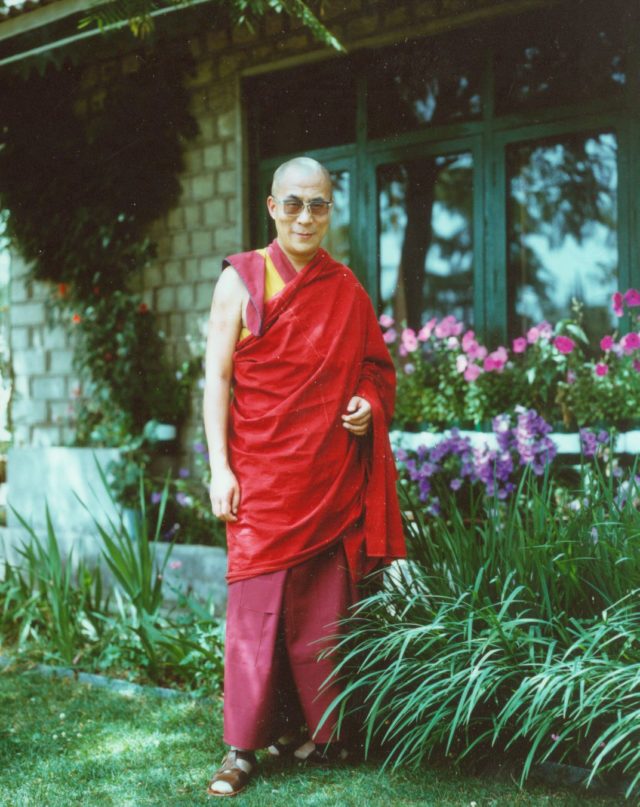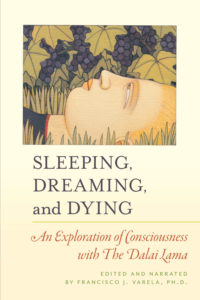The following is an excerpt from Sleeping, Dreaming, and Dying by His Holiness the Dalai Lama.
In order to train in the path that would allow us to transform death, the intermediate state, and rebirth, we have to practice on three occasions: during the waking state, during the sleeping state, and during the death process. This entails integrating the self with spiritual training. Now we have three sets of three:
- Death, intermediate state, and rebirth
- Dharmakaya, Sambhogakaya, and Nirmanakaya
- Sleeping, dreaming, and waking
In order to achieve the ultimate states of Dharmakaya, Sambhogakaya, and Nirmanakaya, one must become acquainted with the three stages of death, intermediate state, and rebirth. In order to become acquainted with these three, one must gain acquaintance with the states of dreamless sleep, dreaming, and waking.
To gain the proper experience during sleep and the waking state, I think it is crucial to become familiar, by means of imagination, with the eightfold process of dying, beginning with the waking conscious state and culminating in the clear light of death. This entails a dissolution process, a withdrawal. At each stage of the actual dying process there are internal signs, and to familiarize yourself with these, you imagine them during meditation in your daytime practice. Then in your imagination, abiding at the clear light level of consciousness, you visualize your subtle body departing from your gross body, and you imagine going to different places; then finally you return and the subtle body becomes reabsorbed in your normal form. Once you are experienced at visualizing this during daytime practice, then when you fall asleep an analogous eightfold process occurs naturally and quickly. That’s the best method for enabling you to recognize the dreamless sleep state as the dreamless sleep state. But without deeper meditative experience of this in the daytime, it’s very difficult to realize this dissolution as you fall asleep.
In the Highest Yoga Tantra practice there are two stages for any sadhana or visualization practice: the stage of generation and the stage of completion. In the stage of generation, the more basic of these two, this whole eightfold process of dissolution is experienced only by the power of imagination; you just visualize it. But in the second stage of practice, the stage of completion, by means of pranayoga, including the vase meditation, you bring the vital energies into the central channel, and you actually bring about such a dissolution, not just with imagination, but in terms of reality. You bring about such a dissolution, and at a certain level of this practice the clear light will manifest.
"The first experience of the clear light occurs as a result of focusing your attention at the heart center of the dream body."
If you’ve arrived at that point in your experience and practice, then it’s very easy for you to recognize the clear light of sleep when that naturally occurs. And if you have arrived at the point where you can recognize dreamless sleep as dreamless sleep, then it’s very easy for you to recognize the dream as the dream.
Different factors are involved in the ability to recognize the dream as dream. One is diet. Specifically, your diet should be compatible with your own metabolism. For example, in Tibetan medicine, one speaks of the three elements: wind, bile, and phlegm. One or more of these elements are predominant in some people. You should have a diet that helps to maintain balance among these various humors within the body. Moreover, if your sleep is too deep, your dreams will not be very clear. In order to bring about clearer dreams and lighter sleep, you should eat somewhat less. In addition, as you’re falling asleep, you direct your awareness up to the forehead. On the other hand, if your sleep is too light, this will also act as an obstacle for gaining success in this practice. In order to deepen your sleep, you should take heavier, oilier food; and as you’re falling asleep, you should direct your attention down to the vital energy center at the level of navel or the genitals. If your dreams are not clear, as you’re falling asleep you should direct your awareness to the throat center. In this practice, just as in using the device sent by LaBerge, when you begin dreaming it’s helpful to have someone say quietly, ‘You are dreaming now. Try to recognize the dream as the dream.’
Once you are able to recognize the clear light of sleep as the clear light of sleep, that recognition can enable you to sustain that state for a longer period. The main purpose of dream yoga in the context of tantric practice is to first recognize the dream state as dream state. Then, in the next stage of the practice you focus your attention on the heart center of your dream body and try to withdraw the vital energy into that center. That leads to an experience of the clear light of sleep, which arises when the dream state ceases.
The experience of clear light that you have during sleep is not very subtle. As you progress in your practice of dream yoga, the first experience of the clear light occurs as a result of focusing your attention at the heart center of the dream body. Although the clear light state during sleep at the beginning is not very subtle, through practice you’ll be able to make it subtler and also prolong its duration. Also, a secondary benefit of this dream body is that you can be a perfect spy.
He laughed in his usual style. Realizing how much time the teaching had taken, and how late it was, he got up, bowed to all present, and left. We slowly gathered our notes and pads, resting in the aura of a knowledge that was both vast and difficult to grasp.
 This is an absorbing account of a dialogue between leading Western scientists and the foremost representative of Buddhism today, the Dalai Lama.
This is an absorbing account of a dialogue between leading Western scientists and the foremost representative of Buddhism today, the Dalai Lama.
For modern science, the transitional states of consciousness lie at the forefront of research in many fields. For a Buddhist practitioner these same states present crucial opportunities to explore and transform consciousness itself. This book is the account of a historic dialogue between leading Western scientists and the Dalai Lama of Tibet. Revolving around three key moments of consciousness—sleep, dreams, and death—the conversations recorded here are both engrossing and highly readable. Whether the topic is lucid dreaming, near-death experiences, or the very structure of consciousness itself, the reader is continually surprised and delighted.
Narrated by Francisco Varela, an internationally recognized neuroscientist, the book begins with insightful remarks on the notion of personal identity by noted philosopher Charles Taylor, author of the acclaimed Sources of Self. This sets the stage for Dr. Jerome Engel, Dr. Joyce MacDougal, and others to engage in extraordinary exchanges with the Dalai Lama on topics ranging from the neurology of sleep to the yoga of dreams.
Remarkable convergences between the Western scientific tradition and the Buddhist contemplative sciences are revealed. Dr. Jayne Gackenbach’s discussion of lucid dreaming, for example, prompts a detailed and fascinating response from the Dalai Lama on the manipulation of dreams by Buddhist meditators. The conversations also reveal provocative divergences of opinion, as when the Dalai Lama expresses skepticism about “Near-Death Experiences” as presented by Joan Halifax. The conversations are engrossing and highly readable. Any reader interested in psychology, neuroscience, Buddhism, or the alternative worlds of dreams will surely enjoy Sleeping, Dreaming, and Dying.
| There are no products in your cart. |

